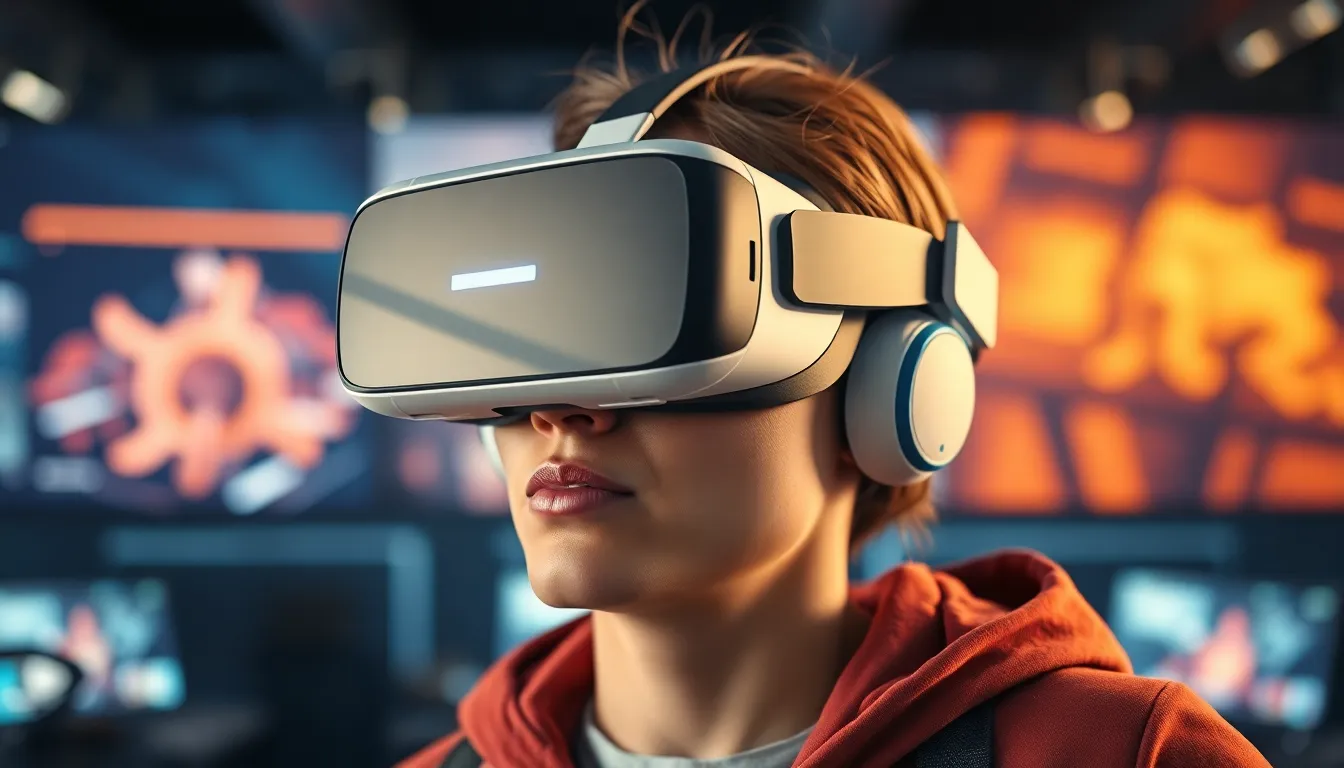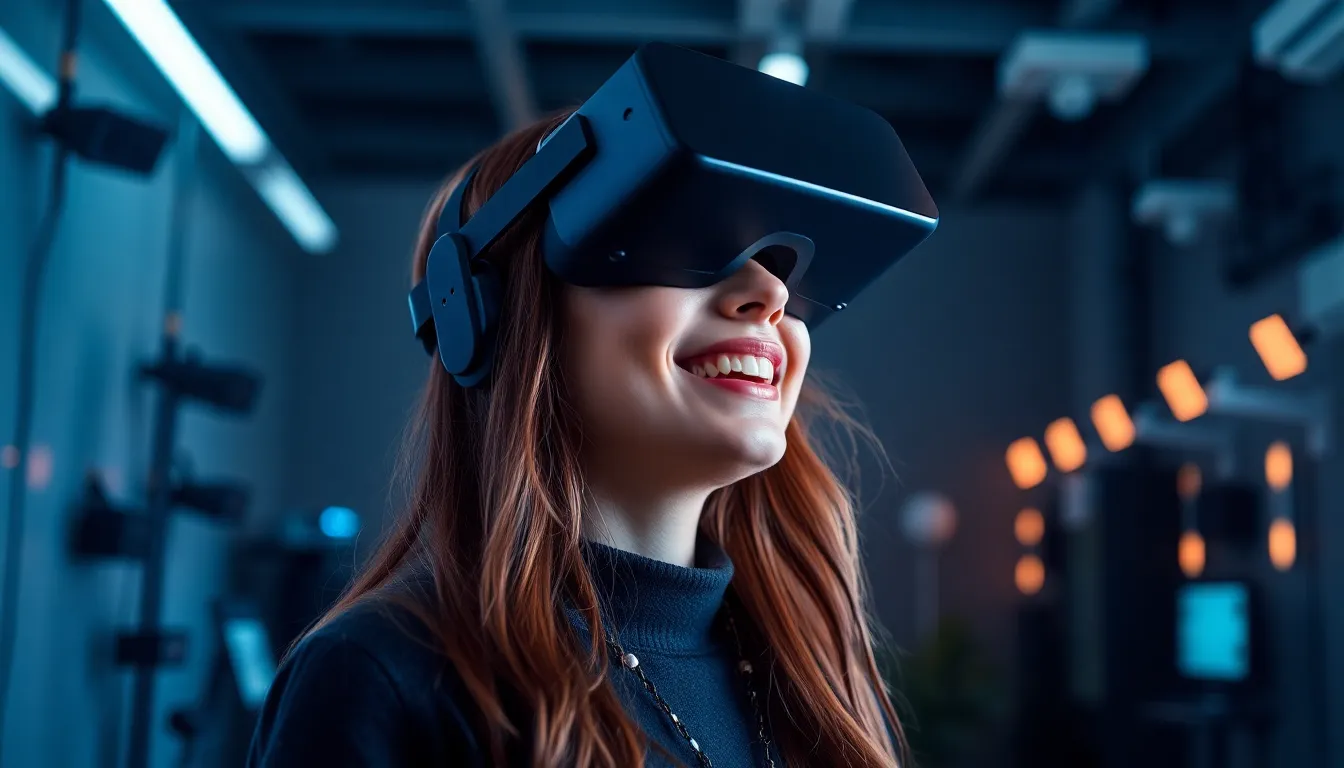Imagine diving into a virtual world where your gaze controls everything. VR eye tracking takes immersion to a whole new level, turning your eyes into powerful tools for interaction. No more clumsy controllers or awkward hand gestures; just a simple glance can navigate menus, select objects, or even unleash spells in a fantasy realm.
Table of Contents
ToggleOverview of VR Eye Tracking
VR eye tracking technology significantly improves user experience in virtual environments. This advanced system allows users to interact with digital elements simply by looking at them. Eye tracking enhances immersion, making virtual reality feel more lifelike. Users engage with objects and environments without relying on traditional controllers or hand gestures.
State-of-the-art cameras and sensors track eye movements with high precision. These sensors detect gaze direction, enabling accurate navigation and selection of items. Eye tracking also benefits gaze-based interaction designs, allowing for seamless incorporation into gaming, training simulations, and social VR experiences.
A notable advantage includes reduced fatigue, as relying on gaze minimizes the physical efforts often associated with prolonged gameplay or exploration. This encourages longer sessions without discomfort. Furthermore, VR eye tracking aids developers in creating personalized experiences through analysis of user attention in real-time.
Integrating this technology affords deeper engagement by adjusting dynamic elements based on where users focus their gaze. Various industries, including education and healthcare, leverage VR eye tracking for training and therapeutic applications. As a result, the potential for innovative solutions and enhanced learning experiences keeps growing as the technology advances.
Overall, VR eye tracking represents a pivotal shift in how users interact with virtual environments, making experiences more intuitive and engaging.
Key Technologies Behind VR Eye Tracking

VR eye tracking relies on advanced technologies that enable precise and immersive interaction within virtual environments. Sensor innovation and software algorithms play crucial roles in its functionality.
Sensor Technologies
Camera-based sensors capture eye movements accurately in real time. These devices can track pupil size, fixation points, and blink patterns. Some headsets utilize infrared technology to illuminate the eyes, enhancing tracking efficacy. Other systems employ dedicated eye-tracking cameras, allowing for greater precision. Additionally, newer models integrate these sensors seamlessly within the headset design, ensuring comfort and usability. Improved sensor technologies contribute to more lifelike experiences, enhancing immersion and minimizing fatigue during extended sessions.
Software Algorithms
Specialized algorithms process the data collected from sensors quickly and efficiently. Such algorithms analyze gaze direction, depth perception, and user intent to create responsive virtual interactions. Machine learning techniques improve performance over time by adapting to individual gaze patterns. Real-time processing enables immediate feedback within the VR environment, fostering intuitive navigation. Furthermore, eye tracking software supports personalization by adjusting content dynamically based on user focus. These software advancements facilitate richer user experiences, expanding the potential for applications across multiple industries.
Applications of VR Eye Tracking
VR eye tracking finds applications across various sectors, enhancing user interaction and experience. This technology brings significant advantages to gaming, healthcare, and research.
Gaming and Entertainment
Gaming utilizes VR eye tracking to create immersive experiences. Players engage their surroundings simply by looking at objects or areas, resulting in intuitive gameplay. Enhanced realism captivates users, and developers leverage eye tracking for personalized content. In multiplayer environments, participant tracking improves strategic elements by allowing players to communicate through gaze. With the ability to analyze attention, games often evolve based on user preferences.
Healthcare and Medical Training
Healthcare relies on VR eye tracking for training professionals effectively. Medical simulations employ realistic scenarios, enabling trainees to practice complex procedures. Trainees track patients’ eye movements, improving diagnosis skills by allowing them to gauge reactions and comprehension. Moreover, eye tracking aids in designing therapeutic exercises for rehabilitation. Customized treatments address individual patient needs, fostering better outcomes.
Research and User Experience
Research employs VR eye tracking to gather critical data on user behavior and interaction patterns. Analysts study eye movement to uncover user preferences and identify areas for improvement in virtual interfaces. Insights gleaned from gaze analysis inform design decisions, enhancing user engagement. In user experience testing, tracking eye movements during task completion reveals pain points, allowing teams to refine applications effectively.
Benefits of VR Eye Tracking
VR eye tracking offers distinct advantages that enhance user experience across various applications. This technology transforms interactions, making them more intuitive and engaging.
Enhanced User Interaction
Users experience more natural engagement in virtual environments through VR eye tracking. Gaze-based control simplifies navigation, allowing them to select objects and execute actions effortlessly. As users look at different elements, the system responds in real time, creating a seamless connection between thoughts and actions. Data from numerous studies indicates that this interaction style increases user satisfaction. Developers implement features that adapt to individual gaze patterns, fostering personalized experiences that resonate with users.
Improved Accessibility
Accessibility improves significantly with VR eye tracking technologies. This innovation allows users with limited mobility to participate in virtual experiences that might otherwise be challenging. Eye tracking enables interaction without physical input devices, making VR environments more inclusive. Many applications incorporate gaze control to accommodate individuals with disabilities, thereby expanding user demographics. According to industry reports, the demand for accessible solutions in VR continues to grow, driving advancements in technology that prioritize usability for all participants.
Challenges and Limitations
VR eye tracking faces several challenges and limitations that affect its broader adoption.
Technical Constraints
Data processing can present hurdles. Adequate hardware is necessary to handle real-time inputs from advanced sensors. Additionally, varied lighting conditions often disrupt the precision of eye tracking. Calibration processes require user interaction and can frustrate some individuals. Eyewear might also interfere with the accuracy of tracking. Each of these factors contributes to inconsistent performance, affecting user experience in virtual environments.
Privacy Concerns
Significant privacy issues arise with VR eye tracking technology. Users often express concern about how their eye movement data might be collected and utilized. The potential for misuse of sensitive information, especially in personal and medical applications, raises ethical questions. Additionally, companies must ensure robust security measures are in place to protect user data. Transparency about data collection practices fosters trust but remains a critical challenge for developers and users alike.
VR eye tracking is revolutionizing how users engage with virtual environments. By allowing control through gaze alone it enhances immersion and simplifies interactions. This technology not only makes experiences feel more lifelike but also caters to diverse user needs, promoting accessibility.
As industries explore its potential the applications of VR eye tracking continue to expand. From gaming to healthcare its ability to create personalized experiences is paving the way for innovative solutions. However challenges such as technical limitations and privacy concerns must be addressed to ensure widespread adoption.
The future of VR eye tracking looks promising. As advancements continue to emerge users can expect even more intuitive and engaging virtual experiences.




